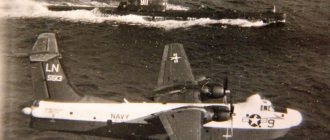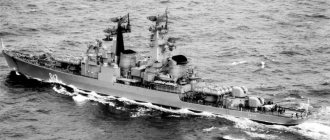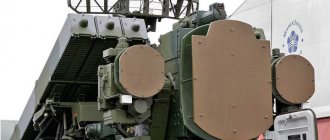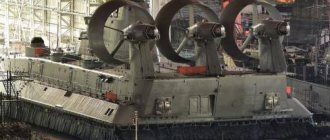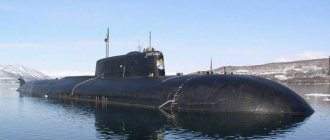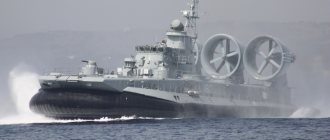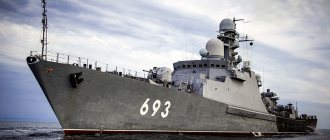Project 11540 “Yastreb” (Nonstrashimy type) – patrol ships (frigates)
One of the few ships introduced into the Russian Navy in the last decade is the patrol ship Neustrashimy, built at a shipbuilding plant in Kaliningrad according to project 11540 Yastreb. The development of the project was started by the design bureau in Zelenograd in 1981; the Project 1135 patrol ship “Burevestnik” was used as a prototype. Patrol ships of this type are designed to carry out convoy operations and patrol duty, search, track and combat enemy surface ships and submarines, and repel attacks by enemy air attacks. Technical capabilities allow ships of this type to remain at sea for a long time and control significant air and water space.
Patrol ship Neustrashimy – video
The lead ship of the 712 series “Neustrashimiy” was laid down on 04/01/1986, launched on 05/01/1988, due to lack of funding, the ship entered service only on 01/24/1993. The second ship, originally called “Unapproachable”, and On 08/30/1995, renamed “Yaroslav the Mudry”, it was laid down on 05/27/1988, and was launched in June 1990. The Neustrashimy class patrol boats are single-tube, two-masted ships with a developed superstructure, occupying more than half the length of the upper deck . The architectural and layout solutions implemented in the ships ensure a reduction in the levels of secondary radar, thermal and electromagnetic fields. The hull is made with an elongated forecastle and a characteristic break in the upper deck at the bow, which improves the conditions for combat use of the 100-mm gun mount. It is made of steel, all connections are made by welding. The hull is divided into 13 compartments by waterproof bulkheads (according to other sources - 12 compartments); the ship's unsinkability is ensured if any three adjacent compartments are flooded. There is a double bottom throughout the entire body. The double bottom space is used as tanks for fuel, oil and fresh water. The stabilization system includes side rudders and retractable roll control rudders. The selected hull contours and the ratio of the main dimensions ensure high seaworthiness of the ship. Stability characteristics do not impose restrictions on its use under unfavorable hydrometeorological conditions.
The three-tier continuous superstructure is also made of steel. All residential and service premises, as well as combat posts, are connected to an air conditioning system. The ship has the necessary means to ensure its fire protection and survivability. There are means of protection against weapons of mass destruction. The hull and superstructure are divided into four citadels, which are equipped with autonomous filter and ventilation units that maintain excess air pressure inside them. Ensuring the protection of personnel is also facilitated by the presence of a closed end-to-end passage from bow to stern. The ship uses a two-shaft gas turbine main power plant, consisting of a propulsion section, including two M70 gas turbine engines, two two-speed gearboxes and a special gearbox, as well as an afterburner section, including two M90 gas turbine engines and two afterburning single-speed gearboxes. To ensure combat survivability, they are divided into two independent power groups on the port and starboard sides, each of which is located in two autonomous engine rooms. The special gear attachment mentioned above ensures, if necessary, that any propulsion unit operates on both shaft lines. Two fixed-pitch propellers are used as propulsors.
The main power plant allows the ship to develop a maximum speed of 30 knots. The cruising range at 16 knots is 3,500 miles. Autonomy in terms of provisions is estimated at 30 days. The electric power plant consists of four electric generators with a total capacity of 3050 kW. The generators produce three-phase current with a voltage of 380 V. The composition of the Neustrashimy's weapons corresponds to its multi-purpose purpose. Artillery armament includes a single-gun automatic 100-mm universal artillery mount AK-100, located on the upper deck in the bow of the ship, and the Kortik anti-aircraft missile and artillery system consisting of two combat modules with missile reloading systems and a command module with a target detection station. The Kortik complex hits air targets with both 9M311 anti-aircraft guided missiles and AK-630M gun mounts. The destruction range is 1.5-8.0 km for missile defense systems, and 0.5-1.5 km for gun mounts. Reach in height - from 5 to 4000 m. Along with the Kortik complex, air and missile defense is provided by the Kinzhal multi-channel anti-aircraft missile system, which includes an below-deck launcher of four launch modules with eight missiles in each, as well as a system control, allowing you to fire simultaneously at four targets located at altitudes from 10 to 6000 m and at ranges from 1.5 to 12 km. The ship's main strike weapon is the Uran anti-ship missile system, which includes four 4-charge launchers located on the lower tier of the superstructure behind the chimney. The complex's missiles can hit surface targets at ranges from 5 to 130 km. Instead of the Uran complex, it is possible to install the Yakhont missile system with twelve anti-ship missiles or the Club-N missile system with sixteen ZM-54E or ZM-54E1 anti-ship missiles, which have greater efficiency and a firing range of up to 300 km.
The anti-submarine weapons include the Vodopad missile system with the Onega ship-based fire control system and six stationary single-tube 533-mm torpedo launchers for firing Vodopad-NK, 83-RN and 84-RN torpedoes or 53-RN torpedoes. 65K and SET-65. The range of hitting targets with missile-torpedoes is from 5 to 35 km, with torpedoes - from 2 to 19 km. The RBU-6000 12-barreled 213-mm rocket-propelled bomb launcher is also designed to destroy submarines, firing depth charges weighing 119.5 kg (the weight of a high-explosive warhead is 23.5 kg) at a range of 5.7 km. The depth of destruction of the target is 500 m. Data for anti-submarine weapons is provided by the Zvezda-1 hydroacoustic complex with underbody and towed antennas. It provides: • search and detection of submarines; • determination of target coordinates; • identification and communication with submarines; • classification of underwater targets; • detection of torpedoes; • issuing target coordinates to the anti-submarine weapon control system and BIUS.
The Ka-27PL helicopter based on the ship is designed to search for and destroy enemy submarines. It can be equipped to provide the Uran anti-ship missile system with over-the-horizon target designation at a distance of up to 200 km from the ship. The unique “brain centers” of the ship are the combat information and control systems “Tron” and “Diplomat”. They combine all the ship's systems into a single integrated complex, which carries out automated interaction of forces and assets in defensive and offensive combat operations. The main functions of these combat information and control systems: • preparation and conduct of combat operations when searching, detecting and striking submarines, surface ships and coastal targets; • air defense; • missile defense; • navigation safety; • control of a helicopter when performing combat missions; • management and ensuring the fight for survivability. The Fregat MA (MR-270) radar, which is part of the ship's radio-electronic armament, is used to illuminate the air and surface situation, detect air and surface targets, and provide target designation to fire control systems. The ship is also equipped with the Vympel-R2 electronic warfare system and PK-2 and PK-10 passive jamming systems.
Tactical and technical characteristics of the ship "Neustrashimiy" Displacement, t: standard 3210 full 4350
Main dimensions, m: maximum length (according to waterline) 131 (123) maximum width (according to waterline) 15.6 draft at full displacement 4.8
Main power plant: gas turbine type, with separate operation of afterburning and main afterburning gas turbine engines - total power, hp. 2x M90 - 40,000 sustainer gas turbine engines - total power, hp. With. 2 x M70 — 17,000 Maximum speed, 30
Cruising range, miles: speed 16 knots 4500 speed 18 knots 3000
Armament: Anti-ship missile complex: type of complex “Uran” number of launchers x guides (type launchers) 4×4 (TPK) ammunition 16 anti-ship missiles
Anti-aircraft missile system: type of complex “Dagger” number of launchers x guides for missiles (type PU) 4×8 (VPU) ammunition 32 missiles 9M330
Anti-aircraft missile and artillery system: type of complex "Dirk" (ZR87E) number of combat modules 2 number of launchers x guides for missiles 2×8 ammunition load 64 missiles 9M311 type of complex AK-630M number of guns x barrels - caliber 2×2 - 30 mm
Artillery complex: type AU AK-100 number of AU x barrels 1×1 caliber, mm/barrel length, caliber 100/60
Anti-submarine: type PLRK "Vodopad" KSUS "Onega" number of RTPU x tubes 6×1 - 533-mm ammunition 24 PLUR "Vodopad-NK", 83-RN and 84-RN or torpedoes 53-65K and SET-65 type RBU RBU -6000 number of RBU x barrels – caliber 1 x 12 – 213 mm ammunition 96 RGB-60 or “Zapad”
Aviation: helicopter type Ka-27PL quantity 1
Crew (including officers), 210 people (35)
Photos of Project 11540 "Hawk" ships
Source


